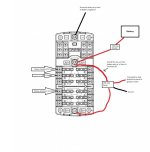- Joined
- Jan 19, 2002
- Messages
- 57
I ordered the Blue Sea Systems split fuse block (https://www.bluesea.com/products/5032/ST_Blade_Split_Bus_Fuse_Block) but it had no directions on how to wire it.
I plan on using Block A for constant power and Block B for accessory. I will likely have more questions when I add some relays but as a starting point does the wiring in the pic look ok?
Can I run a wire from terminal A to terminal B instead if running a second wire from battery POS?
Can I ground the fuse block to the body or would running a cable back to battery NEG be better?
Would this relay work for block B? https://www.amazon.com/dp/B073H4RBFN/ref=cm_sw_em_r_mt_dp_U_kbwvEb464B9YR
I plan on using Block A for constant power and Block B for accessory. I will likely have more questions when I add some relays but as a starting point does the wiring in the pic look ok?
Can I run a wire from terminal A to terminal B instead if running a second wire from battery POS?
Can I ground the fuse block to the body or would running a cable back to battery NEG be better?
Would this relay work for block B? https://www.amazon.com/dp/B073H4RBFN/ref=cm_sw_em_r_mt_dp_U_kbwvEb464B9YR











